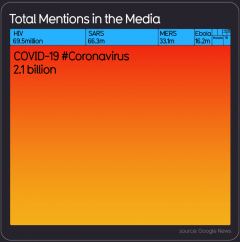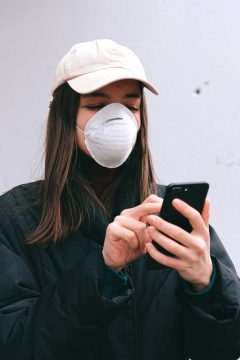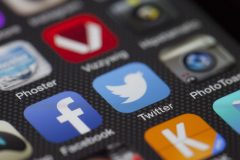By Jyllenna Wilke, Department of Neuroscience
Before the World Health Organization (WHO) labeled COVID-19 a pandemic, they had declared an infodemic. They defined this as “an overabundance of information (some accurate and some  not) that makes it hard for people to find trustworthy sources and guidance when they need it”. In the media, as of March 31, 2020, COVID-19 had some 2.1 billion mentions, a large jump compared to mentions of the Ebola virus at 16.2 million. While the COVID-19 virus is spreading rapidly around the globe, the information and misinformation surrounding it seems to be spreading even faster. Dr. Tedros Adhanom Ghebreyesus, Director-General of the WHO, suggested that “misinformation on the coronavirus might be the most contagious thing about it” (Depoux et al., 2020). Though pandemics and the rapid spread of information, rumors, and panic are nothing new, social media has provided them a megaphone.
not) that makes it hard for people to find trustworthy sources and guidance when they need it”. In the media, as of March 31, 2020, COVID-19 had some 2.1 billion mentions, a large jump compared to mentions of the Ebola virus at 16.2 million. While the COVID-19 virus is spreading rapidly around the globe, the information and misinformation surrounding it seems to be spreading even faster. Dr. Tedros Adhanom Ghebreyesus, Director-General of the WHO, suggested that “misinformation on the coronavirus might be the most contagious thing about it” (Depoux et al., 2020). Though pandemics and the rapid spread of information, rumors, and panic are nothing new, social media has provided them a megaphone.
There are many arguments to be made in favour of social media. Helpful information can be spread just as quickly as misinformation. The WHO set  up a myth-busting page to provide people with accurate and up-to-date information on COVID-19, which they shared on their own social media accounts. Public health agencies around the world are relying on social media to disseminate up-to-date information to citizens. While personal information gathered by social media platforms may be controversial, these data may allow for the delivery of targeted health information based on an individual’s geographical location and the local COVID-19 situation (Dunn et al., 2018). This is particularly important in light of social distancing, as social media may be the only form of connection people have with the outside world, and accurate, relevant information is key.
up a myth-busting page to provide people with accurate and up-to-date information on COVID-19, which they shared on their own social media accounts. Public health agencies around the world are relying on social media to disseminate up-to-date information to citizens. While personal information gathered by social media platforms may be controversial, these data may allow for the delivery of targeted health information based on an individual’s geographical location and the local COVID-19 situation (Dunn et al., 2018). This is particularly important in light of social distancing, as social media may be the only form of connection people have with the outside world, and accurate, relevant information is key.

Empty shelves at a store in Halifax
Potentially the biggest variable with social media is how the people using the platform respond. For example, although COVID-19 does not cause significant bowel distress, stores were selling out of toilet paper and as this was shared extensively on social media, panic and hoarding of supplies ensued. This prevented adequate distribution of resources, resulting in the most vulnerable individuals being left without supplies. On the other hand, social influence is one of the biggest factors influencing individuals to adopt a new health behaviours (Centola, 2013). Social media has been used to promote safe measures and social distancing, increasing social pressures to act in a way that benefits the group. Social media can also be used to call attention to those who need help, and facilitate an organized response. Finally, social media can provide a much-needed sense of social connection when the world feels isolated and uncertain in times of crisis.
In many ways, the current social media landscape is as new as COVID-19. Social media is being adopted by an increasingly diverse demographic. It can serve to spread panic, helpful  information, or promote positive social norms and collective health behaviours. As the pandemic continues, examining how social media is affecting people’s response to COVID-19 may be an important area of study for researchers. Is the abundance of information improving individuals’ responses to the pandemic, or is it making them less likely to take it seriously? I suspect that access to information and social pressure is helping individuals to make choices that benefit the community, such as social distancing, but it may also be increasing the stress associated with the pandemic. Data to answer these questions could be obtained through surveys asking individuals about their responses to COVID-19 and their social media usage, content analysis of posts on social media, and assessing people’s actual behaviour. Some researchers, like Emma Spiro and Kate Starbird at the University of Washington, have already begun to study how misinformation is disseminated through social media. This information could be vital in helping to shape guidelines for social media use in future global health situations.
information, or promote positive social norms and collective health behaviours. As the pandemic continues, examining how social media is affecting people’s response to COVID-19 may be an important area of study for researchers. Is the abundance of information improving individuals’ responses to the pandemic, or is it making them less likely to take it seriously? I suspect that access to information and social pressure is helping individuals to make choices that benefit the community, such as social distancing, but it may also be increasing the stress associated with the pandemic. Data to answer these questions could be obtained through surveys asking individuals about their responses to COVID-19 and their social media usage, content analysis of posts on social media, and assessing people’s actual behaviour. Some researchers, like Emma Spiro and Kate Starbird at the University of Washington, have already begun to study how misinformation is disseminated through social media. This information could be vital in helping to shape guidelines for social media use in future global health situations.
References:
World Health Organization. (2020, Feb 2). Novel coronavirus (2019-nCoV) situation report-13. Retrieved from https://www.who.int/docs/default-source/coronaviruse/situation-reports/20200202-sitrep-13-ncov-v3.pdf
Information is beautiful (2020, Mar 16) COVID-19 #Coronovirus data pack. Retrieved from https://informationisbeautiful.net/visualizations/covid-19-coronavirus-infographic-datapack/
Depoux, A., Martin, S., Karafillakis, E., Preet, R., Wilder-Smith, A., & Larson, H. (2020). The pandemic of social media panic travels faster than the COVID-19 outbreak. Journal of Travel Medicine.
Dunn, A. G., Mandl, K. D., & Coiera, E. (2018). Social media interventions for precision public health: Promises and risks. Npj Digital Medicine, 1(1).
Centola, D. (2013). Social media and the science of health behavior. Circulation, 127(21), 2135–2144.